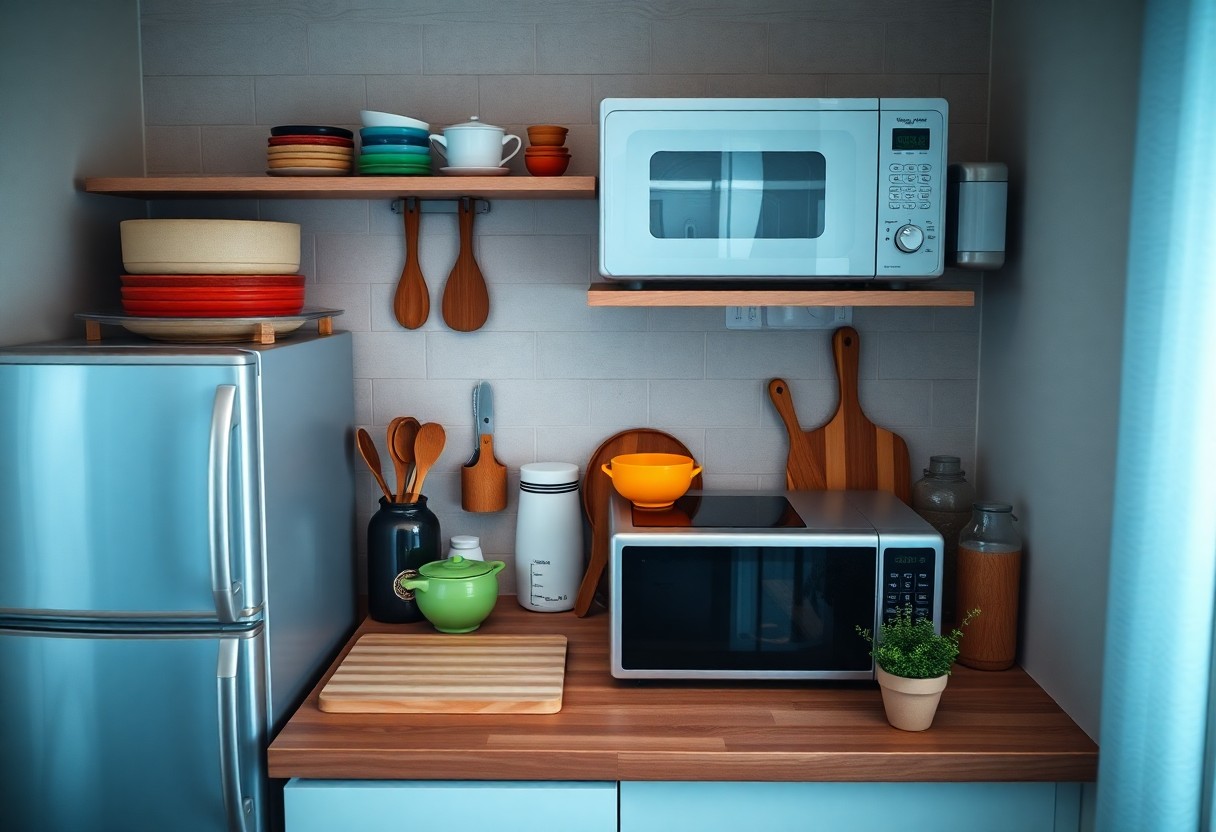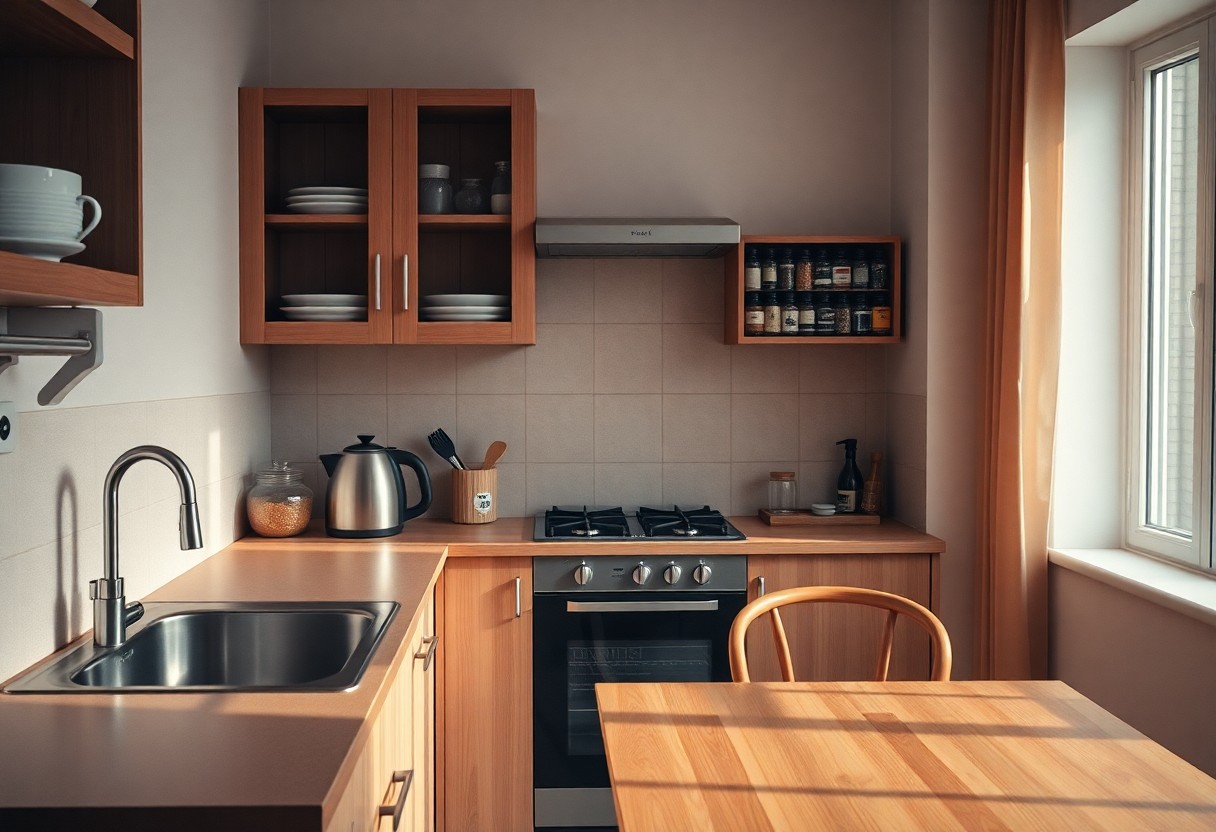Kitchen setups can be overwhelming, especially when trying to stick to a budget. However, with the right approach, you can create a functional and attractive space without breaking the bank. This guide will walk you through crucial tools and smart shopping tips tailored for beginners, ensuring that you invest only in what you truly need while maximizing your culinary experience. Let’s transform your cooking area into a space where your culinary creativity can flourish.

Key Takeaways:
- Focus on imperative tools such as a chef’s knife, cutting board, and a few versatile cooking pots and pans.
- Consider purchasing second-hand or budget-friendly kitchen gadgets to save money while still equipping your space.
- Organize your kitchen efficiently with labeled containers and designated spaces for different tasks, enhancing usability and accessibility.

Assessing Your Kitchen Needs
Start by evaluating your cooking habits and preferences. Are you a novice preparing simple meals, or do you aim to explore various cuisines? Identifying your primary cooking activities helps determine what tools and appliances are necessary for your setup, ensuring you invest wisely without unnecessary extras.
Identifying Essential Cooking Tools
To create a practical kitchen, focus on vital tools like a sturdy chef’s knife, quality cutting board, and versatile pots and pans. These vitals allow for a range of cooking techniques, from chopping vegetables to boiling pasta. Investing in durable items can save you money in the long run, so choose wisely.
Prioritizing Space and Functionality
Your kitchen’s layout significantly impacts culinary efficiency. Make the most of limited space by arranging tools within easy reach and organizing cabinets effectively. Prioritizing functionality ensures that your setup remains user-friendly, allowing for a more enjoyable cooking experience.
Consider integrating magnetic strips for knives, stackable storage containers, and pull-out shelves to maximize your kitchen space. Each of these solutions not only creates a more organized environment but also enhances your cooking process. Efficient layout planning can distinctly improve how you navigate while preparing meals, making your kitchen a more inviting space to cook, socialize, and even entertain guests.
Budgeting for Your Kitchen Setup
Establishing a budget for your kitchen setup is vital. By allocating funds wisely, you can ensure that you obtain the crucials without overspending. Track your priorities and break down costs into categories to maintain control. This method allows you to invest in high-quality items that will serve you well over time.
Setting a Realistic Budget
Your budget should reflect your specific needs and lifestyle. Prioritize crucial items, setting aside funds for versatile tools and appliances that enhance your cooking experience. Aim for a balance between quality and cost to avoid frequent replacements and repairs. This consideration leads to long-term savings and satisfaction.
Tips for Saving Money on Kitchen Supplies
To maximize your budget, explore various strategies for saving on kitchen supplies. Consider purchasing from discount retailers, outlet stores, or during seasonal sales. Take advantage of coupons and cashback offers when shopping online or in-person. This approach helps you acquire quality items without breaking the bank.
- Shop at discount retailers for lower prices.
- Explore seasonal sales for major discounts.
- Use coupons and cashback offers.
- Consider second-hand items to save money.
Being resourceful is key when saving money on kitchen supplies. Buy multi-functional appliances to reduce the number of items needed. Always check online reviews to ensure quality before making purchases, and consider borrowing rarely used items from friends or family. This strategy fosters a more budget-friendly kitchen environment.
- Buy multi-functional appliances to minimize clutter.
- Check online reviews for quality assurance.
- Borrow items instead of buying new.
- Consider second-hand options to cut costs.
Choosing the Right Appliances
Selecting the appropriate appliances can significantly enhance your cooking experience without breaking the bank. Prioritize appliances that offer multi-functionality and a solid reputation for reliability. Aim for a balance between quality and cost by scouting sales, used options, or budget-friendly brands. With careful consideration, you can create a kitchen that meets your culinary needs while staying within your financial limits.
Must-Have Appliances for Beginners
As a beginner, equip your kitchen with appliances that simplify your cooking process. A reliable blender, a compact microwave, and a versatile slow cooker are necessary. Each appliance serves multiple purposes, allowing you to prepare a variety of meals without overwhelming your space. Investing in these key tools will lay a strong foundation for your culinary adventures.
Energy-Efficient Options on a Budget
When considering kitchen appliances, prioritize energy-efficient models to save on utility bills while minimizing your environmental footprint. Look for Energy Star certified products, which meet rigorous efficiency standards. These appliances often reduce energy consumption by at least 10-50%, depending on the model, contributing to long-term savings and sustainability.
Energy-efficient options can fit any budget, with many brands offering affordable choices. For example, consider compact dishwashers or refrigerators that utilize less energy without sacrificing performance. By purchasing appliances with high energy efficiency ratings, you not only save money but also contribute to a more sustainable lifestyle. Over time, the savings on your electricity bill can significantly offset the initial costs, making them a smart choice for any kitchen setup.
Essential Cookware and Utensils
Your kitchen setup demands a few key cookware pieces that will serve you well in a variety of cooking tasks. Aim for a non-stick skillet, a sturdy stockpot, and a versatile cast iron skillet to cover most bases, from frying eggs to making soups. Consider investing in high-quality alternatives that not only perform better but also last longer, saving you money in the long run.
Recommended Cookware Sets
Opting for a cookware set can be budget-friendly, as these often come with crucial items like frying pans, saucepans, and lids. Look for brands that offer a mix of materials, such as stainless steel and non-stick, to match different cooking needs. Sets priced around $100 typically include enough pieces to start cooking effectively while avoiding the depletion of your budget.
Key Kitchen Utensils to Invest In
Invest in a few crucial kitchen utensils that will enhance your cooking experience. A reliable chef’s knife is non-negotiable; it should feel comfortable in your hand and hold an edge well. Pair it with a sturdy cutting board, and add crucials like measuring cups, a spatula, and a whisk for versatile meal preparation.
When identifying utensils, prioritize quality over quantity. A well-balanced chef’s knife can often be the centerpiece of your kitchen, suitable for everything from chopping vegetables to mincing herbs. A good cutting board, preferably wooden or plastic, protects your knife and serves multiple purposes. In addition, a set of durable measuring cups and spoons can ensure baking precision. This strategic investment will equip you to tackle diverse recipes with confidence and efficiency.
Creating a Functional Layout
To optimize your kitchen’s efficiency, focus on creating a functional layout that facilitates movement and access to your imperative tools and ingredients. Position your cooking stations, like the stove and prep area, in proximity while maximizing counter space. For an in-depth look at transforming your kitchen, check out DIY Kitchen Remodel: Your Ultimate Guide to a Budget ….
Tips for Organizing Your Kitchen Space
Effective organization is key to a smooth cooking experience. Start by grouping similar items together, such as utensils and spices, and ensure commonly used tools are easily accessible. Consider these tips:
- Declutter regularly to remove unused items.
- Label containers for quick identification.
- Utilize vertical space with shelves.
- Keep frequently used tools within arm’s reach.
Any adjustments you make can significantly enhance your kitchen’s usability.
Effective Storage Solutions
Maximizing storage in a beginner-friendly kitchen setup involves innovative solutions that fit your budget. Use drawer dividers to keep utensils organized, and opt for stackable containers to save space in your pantry. Consider hanging pot racks or magnetic strips for knives to free up counter space while keeping imperative items within reach. Practical solutions like multi-functional furniture or collapsible items can also help you adapt to limited space without sacrificing functionality.
Shopping Smart
Being strategic in your shopping approach can greatly impact your kitchen setup while staying within budget. Utilize sales, coupons, and seasonal discounts to maximize your savings. Always compare prices at different stores or online platforms, and don’t hesitate to buy used or refurbished items that still maintain quality. Emphasizing quality over quantity ensures that you invest in long-lasting supplies, ultimately saving you money.
Where to Find Affordable Kitchen Supplies
Searching for affordable kitchen supplies can lead you to several hidden gems. Consider local thrift stores, garage sales, and discount retailers for excellent deals on cookware and utensils. Many online marketplaces like Craigslist and Facebook Marketplace also feature second-hand items that are in good condition. These options can help you build your kitchen importants at a fraction of the retail cost.
Tips for Online and In-Store Shopping
Maximize your shopping experience by utilizing both online and in-store strategies. Online, take advantage of price comparison tools and read customer reviews to guide your decisions. In-store, make a list to avoid impulse purchases, and check clearance sections for discounted goods. Utilize loyalty programs where available to enhance savings over time.
- price comparison tools
- customer reviews
- impulse purchases
- clearance sections
Another way to save is by being aware of store return policies. Understanding these can help you make informed purchases, especially if the item doesn’t meet your expectations. Combining online research with in-store visits often leads to better decisions, ensuring you receive the best value for your hard-earned money. After confirming the quality and price comparison, you can confidently make your choice.
- store return policies
- online research
- better decisions
- best value
Final Words
Summing up, establishing a beginner-friendly kitchen setup on any budget involves thoughtful planning and prioritization. Start by identifying your cooking habits to select vital tools that meet your needs without overspending. Invest in multifunctional items to maximize value and consider second-hand options for quality without high costs. Organize your space to enhance usability, making your kitchen a welcoming and efficient environment. With these strategies, you can create a functional kitchen that inspires your culinary creativity without straining your finances.
FAQ
Q: What are the basics for setting up a beginner kitchen?
A: A beginner kitchen should include imperative tools like a cutting board, a chef’s knife, measuring cups, and a mixing bowl. Start with basic cookware, such as a skillet, saucepan, and baking sheet. Having staple pantry items like rice, pasta, spices, and canned goods is also important.
Q: How can I choose budget-friendly kitchen appliances?
A: Focus on multifunctional appliances to maximize utility without overspending. Look for sales, consider used options, and choose well-reviewed brands that offer quality at a lower price point. Prioritize items like a microwave, blender, and toaster that provide imperative functions.
Q: What are some tips for organizing a budget kitchen?
A: Use vertical space by adding shelves or racks, and keep frequently used items within easy reach. Invest in stackable containers to save space and maintain order. Designate specific zones for prep, cooking, and storage to streamline workflow and reduce clutter.
Q: How can I maximize small kitchen space on a budget?
A: Use multifunctional furniture, such as a kitchen island with storage. Install hooks for utensils and pots, and use under-shelf baskets to utilize vertical space. Regularly declutter to ensure that only imperative items are occupying valuable area.
Q: What are some cost-effective meal prep strategies for beginners?
A: Plan meals for the week to buy only necessary ingredients and reduce waste. Batch cooking larger portions can save both time and money, and using leftovers creatively can stretch your budget further. Invest in good containers to keep prepped meals fresh and organized.
